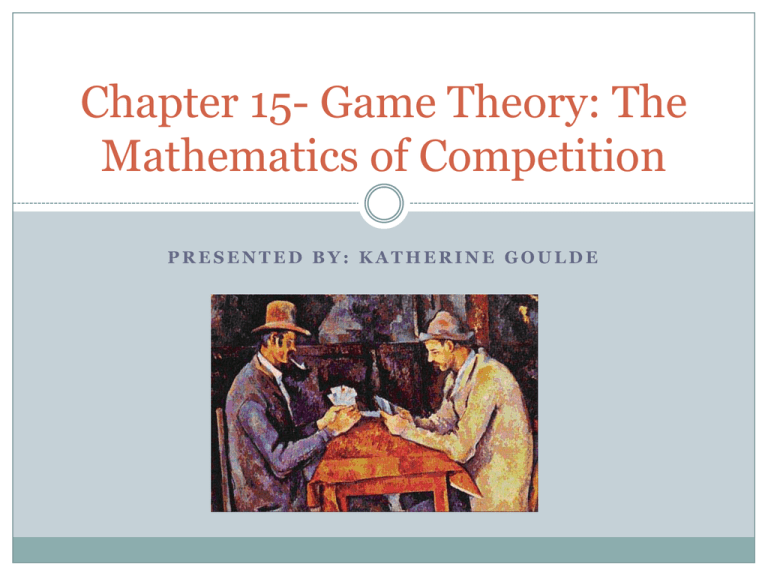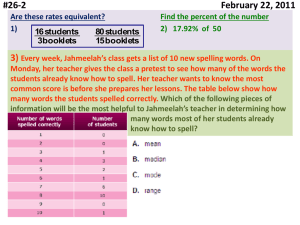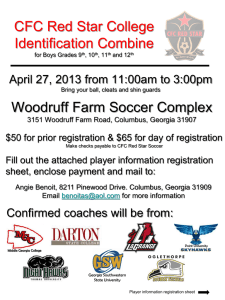Chapter15
advertisement

Chapter 15- Game Theory: The Mathematics of Competition PRESENTED BY: KATHERINE GOULDE Chapter 15 Outline Introduction Two-Person Total Conflict Games: Pure Strategies Two-Person Total Conflict Games: Mixed Strategies Partial Conflict Games Larger Games Extensive Form Games: A sequence of moves Applications of Game Theory First let’s play a little game… Tic- Tac-Toe!!!! - 2 teams - one is ‘X’, the other is ‘O’ -random draw decide order - winner gets 3 in a row What strategies did you use? What was your thought process on each move?? What was your goal for the game? Introduction- Definitions Strategy: one of the courses of action a player can choose in a game; strategies are mixed or pure, depending on whether they are selected in a randomized fashion or not It describes the complete course of action in a game Rational Choice: a choice that leads to a preferred outcome Total Conflict: a zero-sum or constant-sum game, in which what one player wins the other player loses Partial Conflict: a variable-sum game in which both players can benefit by cooperation but may have strong incentives not to cooperate Two-person Total Conflict Game: Pure Strategies Let’s say 2 people (Sally and Bob) are trying to decided on the location of a restaurant near an intersection. Bob wants a higher elevation; Sally wants a lower elevation. Since they need an intersection, they must decide on a east-west highway and a north-south highway. Sally will choose from the 3 the N-S highways; Bob will choose the 3 E-W highways. Two-person Total Conflict Game: Pure Strategies East- West Highways North-South Highways 1 2 3 A 10 4 6 B 6 5 9 C 2 3 7 •The numbers in the chart represent altitude in thousands of feet. •It shows the altitudes at all 9 possible intersections. •A higher number is better for Bob and therefore worse for Sally. (Note-In game theory notation, the payoff matrix in a zero-sum game will always be in terms of the row player) •Sally will choose 1, 2, or 3 and Bob will choose A, B, or C Two-person Total Conflict Game: Pure Strategies •Bob wants to get the highest altitude, no matter what route Sally chooses •Bob is going to look at the minimum of each possible choice. •For A, the minimum is 4 •For B, the minimum is 5 •For C, the minimum is 2. •The largest of these is 5. Therefore Bob can choose route B, and guarantee an altitude of at least 5,000 feet. Two-person Total Conflict Game: Pure Strategies •Sally wants the lowest altitude, no matter what Bob chooses. •Sally is going to look at the maximum for each possible choice •For choice 1, the maximum is 10. •For choice 2, the maximum is 5. •For choice 3, the maximum is 9. •The smallest of these is choice 2. So Sally can guarantee an altitude of 5,000 feet by choosing Highway 2. Two-person Total Conflict Game: Pure Strategies So Bob chooses B and Sally chooses 2, and they locate their restaurant on a location with an altitude of 5,000 feet. Bob strategy was to find the ‘maximin’, and Sally’s strategy was to find the ‘minimax’. The resulting outcome for the couple is called a ‘saddlepoint’. Two-person Total Conflict Game: Pure Strategies Maximin: In a two-person zero-sum game, the largest of the minimum payoffs in each row of a payoff matrix Maximin strategy: the pure strategy of the row player corresponding to the maximin in a payoff matrix Minimax: In a two-person, zero-sum game, the smallest of the maximum payoffs in each column of a payoff matrix Minimax strategy: the pure strategy of the column player corresponding to the minimax in a payoff matrix. Saddlepoint: In a two-person constant-sum game, the payoff that results when a row minimum and a column maximum are the same, which is the value of the game (it is also a Nash equilibrium) Value: The best outcome that both players can guarantee in a two-person zero-sum game. If there is a saddlepoint, this is the value. If not, it is the expected payoff using mixed strategies What if we changed the game??? What if a terrible storm came through and highways B and 2 were permanently closed?? North-South Highways E-W Highways 1 3 A 10 6 C 2 7 Bob must choose either A or C. He will use the maximin strategy. Sally must choose either 1 or 3. She will use the minmax strategy. What route will Bob choose? What route will Sally choose? Bob will choose A. Sally will choose 3. The value is 6,000 feet. Is this a saddlepoint? No, because the maximin does not equal the minimax. Two-person total conflict game: Mixed strategies Matching Pennies Game! Rules: There are two players, and each throws a penny which will be either heads or tails. If they match, player 1 receives both coins If they don’t match, player 2 receives both coins Before we play, let’s construct a payoff matrix. Player 2 Player 1 Heads Tails Heads 1 -1 Tails -1 1 Matching Pennies What were your strategies? Did you have any? It would be pointless for one player to try to outguess the other; therefore one should use mixed strategies. If we think about it probabilistically, how often should player 1 choose heads? How often for tails? What about for player 2? Matching Pennies The best that Player 1 can do is randomly select Heads half the time and Tails half the time. (pH, pT) = (p1, p2) = (p, 1-p) = (0.5, 0.5) Then Player 1’s expected value is: EH = 0.5 (1) + 0.5 (-1) = 0 when player 2 plays heads ET = 0.5 (-1) + 0.5 (1) = 0 when player 2 plays tails Therefore zero is Player 1’s mixed strategy value Similarly, Player 2’s optimal mixed strategy is a 50-50 mix, which gives an expected value of zero. This game is fair: its value is 0, and it favors neither player when at least one player uses an optimal strategy Note*-When using mixed strategies, the opponent doesn’t know what the other will pick in any given play. This aspect of the game is random. Nonsymmetrical Game in Mixed Strategies Player 2 Player 1 Heads Tails Heads 5 -3 Tails -3 1 Nonsymmetrical game: A two-person constant sum game in which the row player’s gains are different from the column player’s gains, except when there is a tie Let’s look at this in mixed strategies. Let ‘p’ be the probability that Player 1 chooses Heads, and ‘1-p’ be the probability that Player 1 chooses Tails. Let ‘q’ be the probability that Player 2 chooses Heads, and ‘1-q’ be the probability that Player 2 chooses Tails. Nonsymmetrical Game in Mixed Strategies Player 2 Player 1 Heads Tails Heads 5 -3 p Tails -3 1 1-p q 1-q Then Player 1’s expected payoff is: EH= 5(p) + (-3)(1-p) assuming that Player 2 plays Heads ET = (-3)p + 1(1-p) assuming that Player 2 plays Tails And Player 2’s expected payoff is: EH = (-5)q + (3)(1-q) assuming that Player 1 plays Heads ET = 3q + (-1)(1-q) assuming that Player 1 plays Tails Nonsymmetrical Game in Mixed Strategies Let’s look at Player 1 first. There are two ways to think about it: 1) What is the best that Player 1 can do, regardless of player 2’s choice In this case, Player 1 will want both of the expected values to be equal, so that he receives the same no matter what player 2 chooses. So EH = ET. 5(p) + (-3)(1-p) = (-3)p + 1(1-p) 12p = 4 p = 1/3 Heads will be chosen 1/3 of the time and Tails 2/3 of the time. This guarantees an expected payoff of -1/3 Nonsymmetrical Game in Mixed Strategies There is a second way to look at it. The best that Player 1 can do is to make Player 2 indifferent between heads and tails. So, Player 2’s payoffs are equal. EH = ET. But how can Player 1 affect 2’s payoffs? Express them in terms of p. The expected value of 2 choosing Heads is: -5p + 3(1-p) The expected value of 2 choosing Tails is: 3p + (-1)(1-p) Set them equal to each other and we get p= 1/3. We can plug in to find the expected payoff for player 2. Nonsymmetrical Game in Mixed Strategies So Player 1 chooses Heads 1/3 of the time and Tails 2/3 of the time. Player 2 equivalently will choose Heads 1/3 of the time and Tails 2/3 of the time. The expected payoff for Player 1 is -1/3 The expected payoff for Player 2 is 1/3. This was a zero-sum game: one in which the payoff to one player is the negative of the corresponding payoff to the other, so the sum of the payoffs is always zero. What would happen if we varied from the optimal solution??? Partial Conflict Games In the real world, not every player’s loss is another player’s gain. For example, both may benefit or both may lose. Games of partial conflict are variable-sum games, in which the sum of payoffs to the players at the different outcomes varies. Now, let’s play another game!! Partial- Conflict Game Team Awesome Team All-Star Strategy A Strategy B Strategy 1 (2,2) (4,1) Strategy 2 (1,4) (3,3) In this case, both teams have Dominant Strategies. Dominant Strategy- a strategy that is sometimes better and never worse for a player than every other strategy, whatever strategies the other players choose The dominant strategies are Strategy 1 and Strategy A. This leads to a special type of game called the Prisoner’s Dilemma. Prisoner’s Dilemma- a 2-person variable sum symmetric game in which each player has two strategies, cooperate or defect. Cooperate dominates defect for both players, even though the mutual-defection outcome, which is the unique Nash equilibrium, is worse for both players than the mutual-cooperation outcome. (note*- the outcome may change in repeated play) Real-world example: Arms race Nash Equilibrium- strategies associated with an outcome such that no player can benefit by choosing a different strategy, given that the other players do not depart from their strategies. Partial-Conflict Games Let’s play another type of game!! Partial- Conflict Game Toyz-R-Our-Thing Kool Toyz Don’t Release Release EXTERM. 3000 Don’t Release (3,3) (2,4) Release EXTERM. 3000 (4,2) (1,1) This game is an example of a type of game called Chicken. Chicken: a two-person, variable-sum symmetric game in which each player has two strategies: to swerve to avoid a ‘collision’ or not to swerve if the other swerves. Neither player has a dominant strategy; the compromise outcome in which both players swerve, is not a Nash equilibrium. What are the Nash equilibrium? Why? Real-world applications: labor-management disputes, international crises Larger Games These simultaneous choice games can be extended to more than 3 players and more than 3 choices. We use the concepts of dominant and dominated strategies to reduce the game to a manageable size. Dominated strategy: a strategy this is sometimes worse and never better for a player than some other strategy, whatever strategies the other players choose In larger games, there may not be just one solution, but instead many Nash equilibria. Larger Games: Example Lets say that three women want to start a public garden. If one contributes, the garden will be small. If two contribute, the garden will be medium. If all three contribute, the garden will be large. If none contribute, there will be no garden. No matter if a player contributes or not, she will be allowed to enjoy the garden. Given the cost and benefits of the garden, each player ranks the outcomes as follows (in decreasing order): The others contribute and she does not All three contribute 1 player contributes, the other doesn’t, and she does not She contributes, another contributes, and the 3rd does not All three don’t contribute She contributes and no one else does Larger Games: Example Player 3 contributes Player 3 doesn’t contribute Player 2 Player 1 Player 2 Contribute Don’t Contribute 5, 5, 5 3, 6, 3 Don’t 6, 3, 3 4, 4, 1 •Does Player 1 have a dominant strategy? •Does Player 2 have a dominant strategy? •Does Player 3 have a dominant strategy? Player 1 Contribute Don’t Contribute 3, 3,6 1, 4, 4 Don’t 4, 1, 4 2, 2, 2 •Each player has a dominant strategy not to contribute, which leads to a pure-strategy equilibrium. •Also a Nash Equilibrium. •Can be found using cell-by-cell inspection. •What type of simultaneous game is this? Extensive Form Games: Game Trees Sometimes, the game may not be ‘simultaneous choice’ but instead of sequence of choices (these are called sequential move games and are often modeled using a game tree) The game tree is referred to as the extensive form of the game. Node: the point from which a branch emerges Initial node (or root): the first node in the game Decision node: represents a point where action is taken Terminal node: the last node along each path Branches: represents one action that can be taken at that node Extensive Form Games: Game Trees Let’s say there are 2 monkeys and 1 tree with 5 bananas. There is a Big Monkey and a Little Monkey. One monkey will move first, then the other after. Extensive Form Games: Game Trees Let’s use Backwards Induction to solve this. Extensive Form Games: Game Trees What are little monkey’s strategies?? •Climb if Big Monkey climbs •Climb if Big Monkey doesn’t climb. What are Big Monkey’s Strategies? •Always Climb. What is the resulting payoff?? Would this change if we changed the order?? Extensive Form Games: Game Trees When all players choose their optimal strategies found by doing rollback analysis, we call this set of strategies the rollback equilibrium of the game Game trees can be used for many players with many possible choices. Tic tac toe, for example, could be modeled in a game tree. (a very very large one) What are some other sequential move games?? Ex: campaigning in states and elections could be modeled Discussion What do you think of the different type of games? (simultaneous choice, zero-sum, pure/mixed strategies, prisoner’s dilemma, chicken, extensive form) Where do you see applications of these? In politics? The military? In the classroom? In relationships? In sports? What might be some impractical assumptions of game theory? Regarding rational choice, or perfect knowledge? Homework: 7th edition- pg585 #15, pg 587 #23






